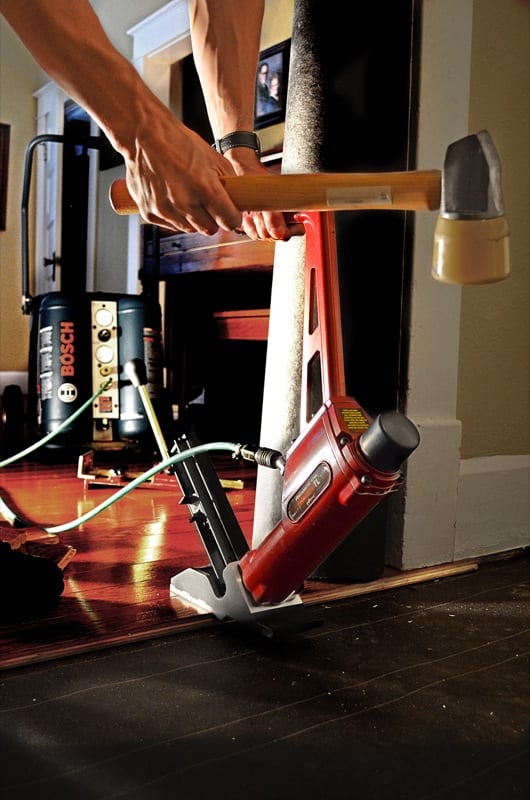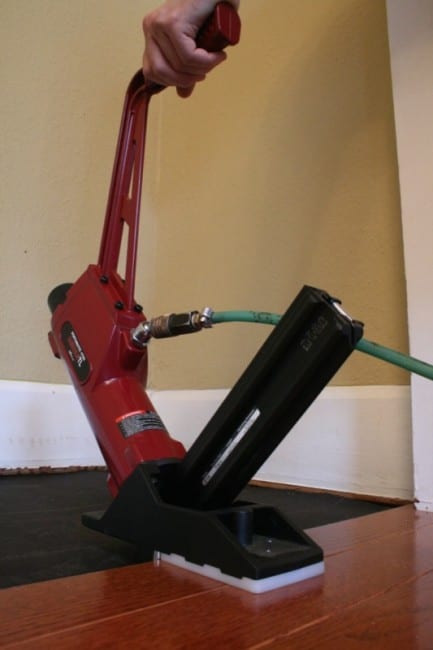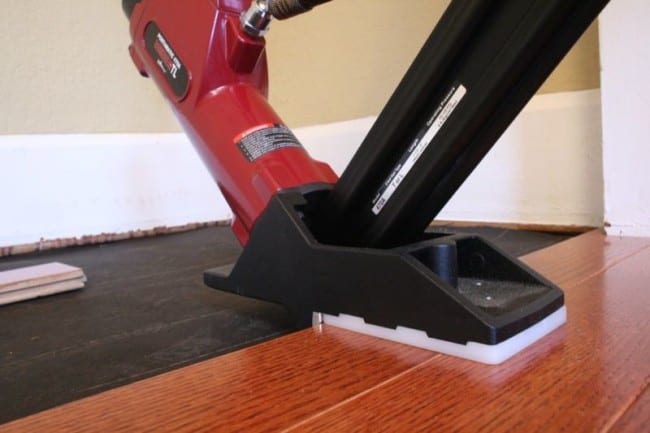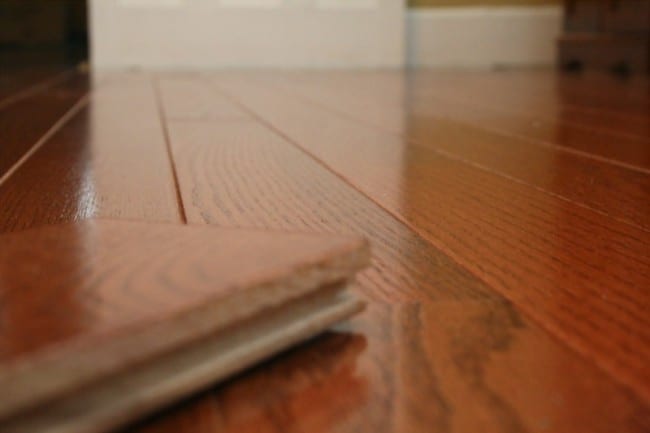Having both refinished and installed hardwood flooring in several homes, going from a manual nailer to a pneumatic is a bit of a jump – but a welcome one. As anyone who has done flooring knows, the two tools work in basically the same way, but with one exception. With a manual flooring nailer, the very act of striking the rubber ram cap drives the ratcheting mechanism which sends the cleat into the wood until it’s all the way in (typically a couple of hits). With most decent floor nailers, the ratchet will then reset when the nail is at the correct depth. The Porta-Nails 470A Pneumatic Flooring Nailer is a pneumatic model which uses 80-90 PSI of air pressure to drive the nail into 1/2″ to 3/4″ tongue and groove flooring with a single, less-aggressive strike. We were taking on a project to lay over 1200 square feet of Harris Wood Red Oak (Dark Gunstock) in a craftsman-style home. This was a pretty big job, and we needed a tool to get it done quickly as the residents were planning on staying in the home while the work was being done. That meant lots of planning and furniture moving – but it also meant that we wanted to be able to go to town quickly and lay flooring in a fast and very efficient manner. In addition to this tool, we also had a Bostitch SmartPoint nailer to handle the wood at the edges of our walls.
Porta-Nails 470A Pneumatic Flooring Nailer Build Quality
Taking a look at the Porta-Nails 470A Pneumatic flooring nailer we noticed that it was nice and tall – 23″, in fact, which is one of the longest handled products we’ve used. This is a characteristic you want in a flooring nailer as, invariably, your back is going to get sore after extended use. And the shorter the handle, the faster you’ll find yourself reaching for the pain reliever… Typically, flooring nailers range in height from 17″ to over 24″, so the Portamatic 470A is one of the most ergonomic in terms of design. One drawback to good ergonomics, however, is the fact that the extra-long handle does make the tool a tad top-heavy. There are no protective rubber side bumpers, so we found that we tended to want to put it in an area where it wouldn’t fall over and ding up any wood. This is also an indictment of how robust this tool is. The steel in both the handle and the magazine looks like it will last a lifetime and we think there’s a good chance a drop down a flight of stairs wouldn’t result in much more than a few scratches… not that we were tempted to test that theory…
Porta-Nails has its characteristic burgundy powder-coated color scheme for the body and handle, with a black shoe and magazine. At the top is the trigger mechanism which “arms” the tool and allows the pneumatic mechanism to function when you strike the ram cap with the hammer. With pneumatic nailers like this one, you’re actually not supposed to strike the rubber ram cap unless the trigger is squeezed. If you want to rack the wood into place you need to use the included mallet as the mechanism in the tool can become damaged if it is struck repeatedly without the trigger pulled.
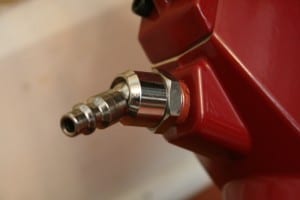
The Porta-Nails 470A also includes a non-marring shoe that was, for us at least, preset for use with our ¾” Harris Wood red oak flooring. The shoe, which can be reversed for ½” hardwood, nestled perfectly onto the tongue of our Harris Wood Red Oak Dark Gunstock. Since we were laying down 1200 sq. ft. of wood flooring, we were glad to find that the shoe was well-designed and slid easily over the pre-finished oak without scuffing it up. The nailer is also reasonable in weight, coming in at around 10 pounds.
Porta-Nails Portamatic 470A Flooring Nailer Testing
Rather than a ratcheting system, the Porta-Nails Portamatic 470A Pneumatic Flooring Nailer or “Hammerhead TL” takes just one hit to drive in the nail, as you’d expect. The trigger safety readies the tool to drive a nail and, as we mentioned, the Portamatic is really only designed to be used as a pneumatic device (and not as a surrogate mallet). There is no ratcheting mechanism and the ram cap must be struck firmly in order to drive the nail all the way in. Hit it half way and the nail is likely to end up sticking out of your tongue. Even so, it’s tons easier to drive than a manual cleat nailer.
And as for the nails, the 470A takes both L-style and T-style nails, and we used both with identical results. Loading the nailer is a simple matter of dropping the nails in from the top of the magazine and then pulling back on the spring tensioner to load the nails into place and get the gun ready to fire.
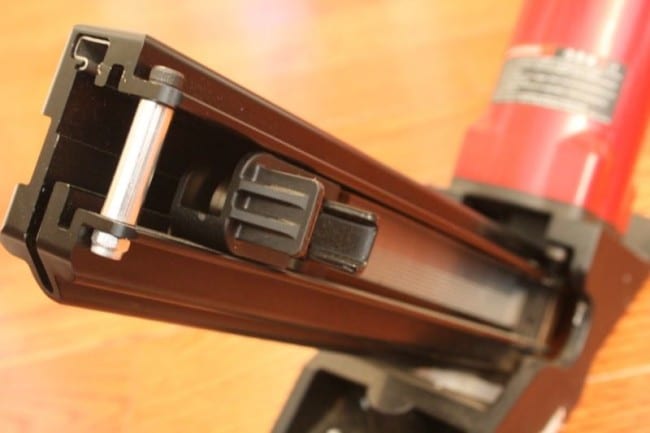
We laid out our main room, a combination dining room and living room separated by a couple of built-in half-height bookshelves, and set to work on driving in the ¾” red oak boards. What we found was that the Portamatic-TL was very quick. This isn’t the first pneumatic flooring nailer we’ve used, but what was certain was that there was nothing in the mechanism or the use of the tool that slowed us down. We could bang in a long row of nails in quick succession and with no real issues. Each day that we set up for our work we added a few drops of oil into the swivel inlet to lubricate the internal parts. This is especially important if you work in hot, humid climates like Central Florida. Draining the air compressor each day, you realize that there is a lot of potential for moisture to encroach into the tool.
The included mallet allowed us to pop and rack the wood easily into place before reaching for the Portamatic-TL nailer. The mallet has the standard curved back which allows it to strike the wood underneath the tongue and in a way that doesn’t mar the surface of the wood flooring. Once in place, the nailer glided easily down the board, letting us secure it in place and giving us ample power to ensure that our mallet blow drove the wood tight even as the nail was fired into place. There is no depth adjustment for the nailer, so altering your air pressure is how you’ll ensure the proper depth of fire. In our case the tool seemed very consistent and 90 PSI was our sweet spot. When we did encounter the odd curved board, we reached for the Porta-Nails #47100 Hardwood Flooring Jack which usually did the trick.
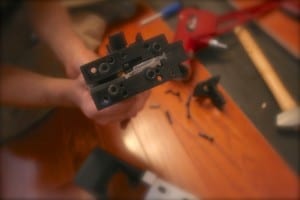
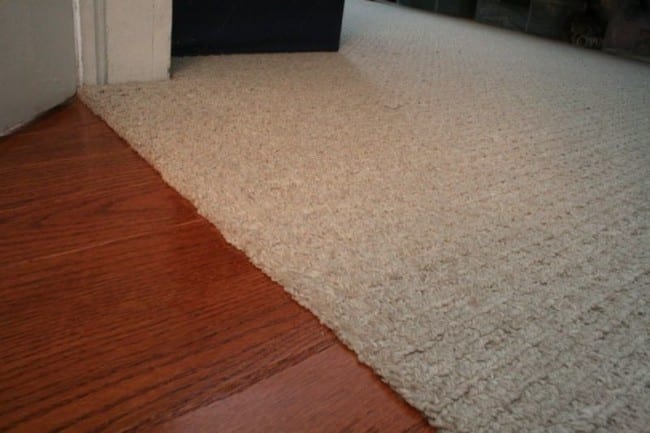
Conclusion
We’ve used a lot of different floor nailers and while the pneumatic models don’t come cheap, they are a far better way to do larger amounts of solid wood flooring and will pay for themselves over and again in time saved. Of course, they’ll also save your back! Porta-Nails’ 470A Portamatic-TL Flooring Nailer is a solid product with only a few areas where improvement would be welcome. The Portamatic 470A is priced right in the middle of the pack as far as retail is concerned for pneumatic flooring nailers, which makes it a decent value. The tool is solid, the included case is robust, and it accomplished a lot of work quickly and easily. Add it all up and what more can you really ask for? Highly recommended. The tool is available online and at Home Depot and other retailers, so if you’re about to lay some flooring you would do well to save your back and your time and pick one up.

